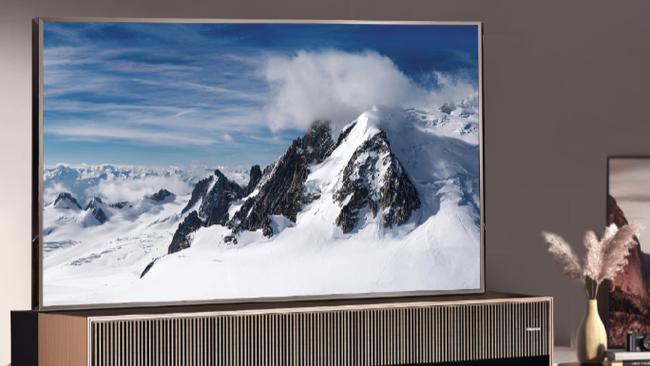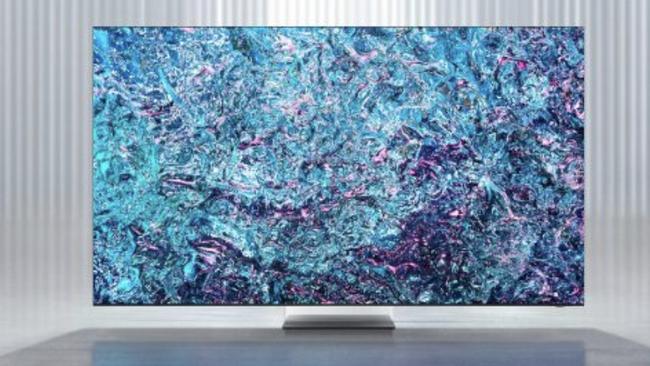CES Las Vegas 2024: the new TVs from Hisense, LG and Samsung
A TV that can disappear, and another which can make old movies appear new thanks to AI are what big manufacturers have in store this year.

Thinner, bigger, brighter — smarter? TV makers are pulling out all stops to keep sales rolling as the economy is set to slow this year, launching their latest products at the world’s biggest consumer electronics show in Las Vegas this week.
The TV market can be overwhelming, with its litany of acronyms such as OLED, ULED and QLED to describe the viewing experience, and the advent of AI has made things even more muddled as manufacturers attempt to convince shoppers it will enhance their lives.
In the real world, particularly in Australia, most consumers want to be able to watch TV without much glare in their sun-drenched lounge rooms. They also want an audio experience which doesn’t sound like it’s coming from a tin can.
The big TV makers have launched a range of technology over the past decade to resolve this issue as well as provide a more immersive experience. But how much better can the tech get? And is it worth upgrading in 2024 or saving money?
Unlike smartphones, people don’t buy a TV every two or three years. The upgrade cycle for televisions is around five to seven years, so when looking at this year’s line-up it’s better to compare with what was on the market in 2019 or 2017.
But even then, the TV makers have a few new tricks up their sleeves this year. Here’s our top picks.
Hisense goes super bright
Hisense launched its ULED screens more than a decade ago, but says its TVs equipped with its latest Mini-LED technology “raises the benchmark for brightness and clarity”. It says it does this by increasing the number of backlights and dimming zones to create a more detailed picture that can withstand the glare of Australian living rooms.
For example, in its new U8NAU model, it now has more than 1000 dimming zones and up to 2000 nits of brightness - an increase from 500 and 1300 respectively last year.
But it’s Hisense’s new massive 110 inch TV that sent jaws dropping, featuring more than 40,000 backlights and up to 10,000 nits of brightness. Confused? The average car headlight produces about 1000 nits on high beam.
Hisense ANZ head of marketing Gideon Liu said the new Mini-LED range “delivers a vivid viewing experience in the sunlit and airy living spaces of Australian homes”.

Hisense’s new 110UX TV, which has a 110 inch display that’s about 10 times brighter than car headlights on high beam.And if the 110 inch model is too big for your lounge room, Hisense has introduced a smaller 65 inch model to the line-up.
As well as more lights, Hisense has harnessed AI to improve picture quality further, with its X-Chipset. What that means is the TV can recognise a particular scene and make real-time adjustments to provide a clearer display.
Hisense has also introduced a new soundbar range, featuring 5.1 2 Dolby Atmos with seven speakers to create what it calls an “enveloping experience”, as well as a new C1 TriChroma Laser Mini Projector.It can project screen sizes from 65 to 300 inches, with Dolby Vision and Dolby Atmos built into the range.Mr Lui acknowledged the high cost of living from the RBA’s most aggressive series of interest rate hikes in 30 years.
“We continue to listen to our customers and respond accordingly – this year’s range makes premium features available to more customers at a time when hip pocket pressure is at an all-time high,” he said.
LG’s transparent TV
The Korean electronic titan showcased only one product during its keynote at CES — and you had to look twice.
LG unveiled the world’s first transparent OLED TV. For years companies have teased consumers with see-through TV prototypes, but LG said its 77-inch Signature OLED TV is set to be available for sale later this year and have superior picture quality than past mock-ups.
The wireless TV almost disappears when switched off, leaving only a frame. “People want larger TVs but the more they grow in size, they take up more and more of your space,” LG said.
“LG Signature OLED T liberates users from a dominant black screen that competes with the decor in their home. No longer does the TV have to be placed against the wall. Instead, place the OLED T in the middle of the room to become a divider or prop it against the window without blocking the view outside.”
But the OLED T also features a “contrast screen” that can be raised behind its 4K transparent screen to turn it into a regular looking TV. Pricing is yet to be disclosed, but it most likely won’t be cheap. LG’s rollable unveiled at CES in 2021 had a $130,000 price tag.
Like Hisense, LG also launched a new AI-powered processor to provide more “lifelike” picture quality. The processor can analyse pixel levels, to effectively sharpen objects and backgrounds that may appear blurry.
Samsung goes transparent, launches smart subtitles
Samsung unleashed major updates to its Neo QLED 8K television, a TV which can turn old movies new, with a smarter processor which harnesses AI to touch up content in real time.
The processor, called NQ8 AI Gen3, is now able to sharpen images and brighten them, which leaves old movies looking as if they were filmed just several years ago.

It can also read subtitles to the vision impaired and will be able to translate them into several languages in real time.
The TV is noticeably thin at just 12.9mm, only slightly thicker than the company’s Galaxy smart watch.
The Neo QLED 8K arrives on what the company calls ‘infinity air,’ a stand which provides a mirror-like reflection which can make it appear as if the TV is floating or wall mounted depending where it is located.
Similarly to LG, Samsung also used CES to unveil its first foray into the transparent TV market, delivering a TV which uses MICRO LED technology.
The company is confident this type of TV will turn a window into a world of streamed content, among other entertainment.
While not yet launched to consumers, the Korean tech powerhouse has demonstrated the concept and showcased how it believes the future of entertainment devices isn’t simply single use.
Also unveiled were improvements to the company’s Premiere Projector which can now stream content in 8K and up to 150 inches in size.
The Premiere, part of the company’s lifestyle TV range, is one of the first products to use Samsung’s wireless transfer technology which allows the user to store the device powering the unit up to 10m away from the projector, storing it out of sight by a power point. It’s also the first in the world to wirelessly transfer 8K content.

Those improvements might seem unnecessary for most, but Samsung’s head of lifestyle TVs Wonki Kim said innovative upgrades and targeting niche markets was how the company planned to grow.
“If we are only positioning our TV market to only target people who are replacing their TV, I think that number is quite small and we cannot grow business,” he said. “By using our lifestyle category, I think we can tap into different sectors where people might not have thought about buying a TV, whether it’s as an interior design piece or outdoor home cinema.”
Te lifestyle category includes The Frame, a TV which when not in use can visually display art as well as Music Frame, a similar concept introduced at CES which doubles as a speaker rather than a TV.
The Music Frame can double as a soundbar for TVs while giving the appearance of an artwork. It can also be positioned on a desk or table with a stand.
Samsung has big expectations for the Music Frame after finding early success with the Frame TV, which on average sees 10 hours of use per day, four hours of television use and six hours of use in art mode.
*The authors travelled to Las Vegas as guests of Hisense and Samsung.





To join the conversation, please log in. Don't have an account? Register
Join the conversation, you are commenting as Logout